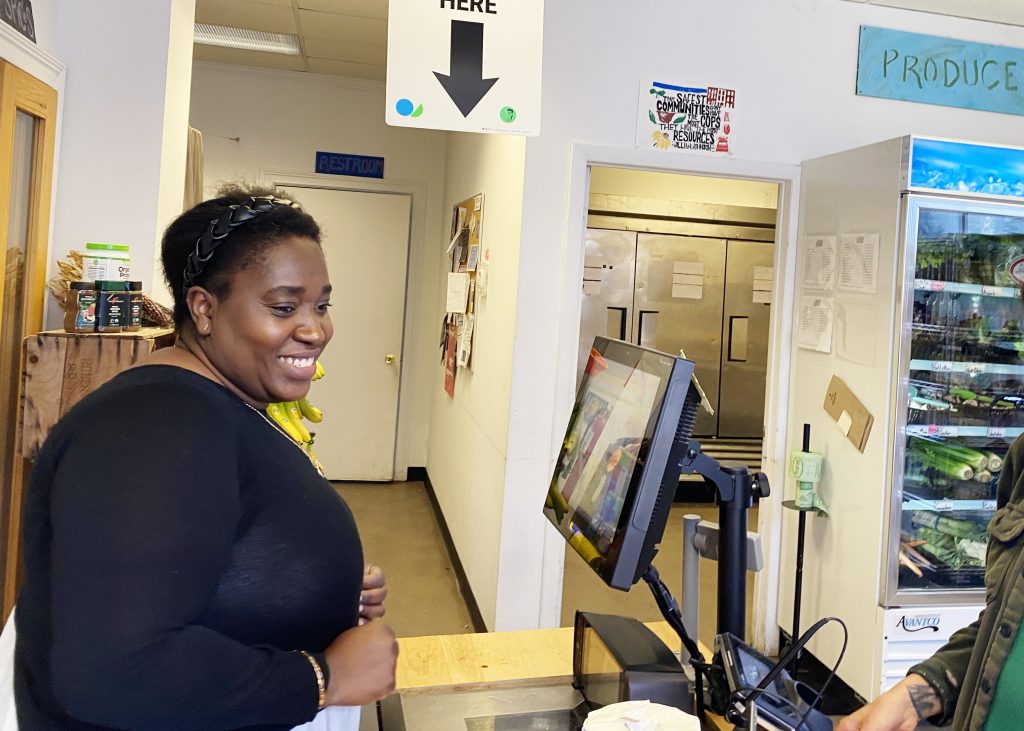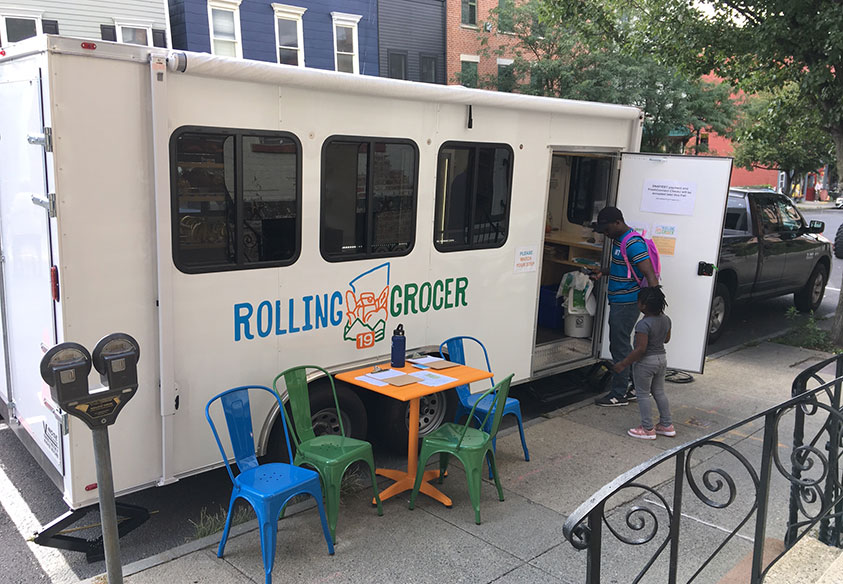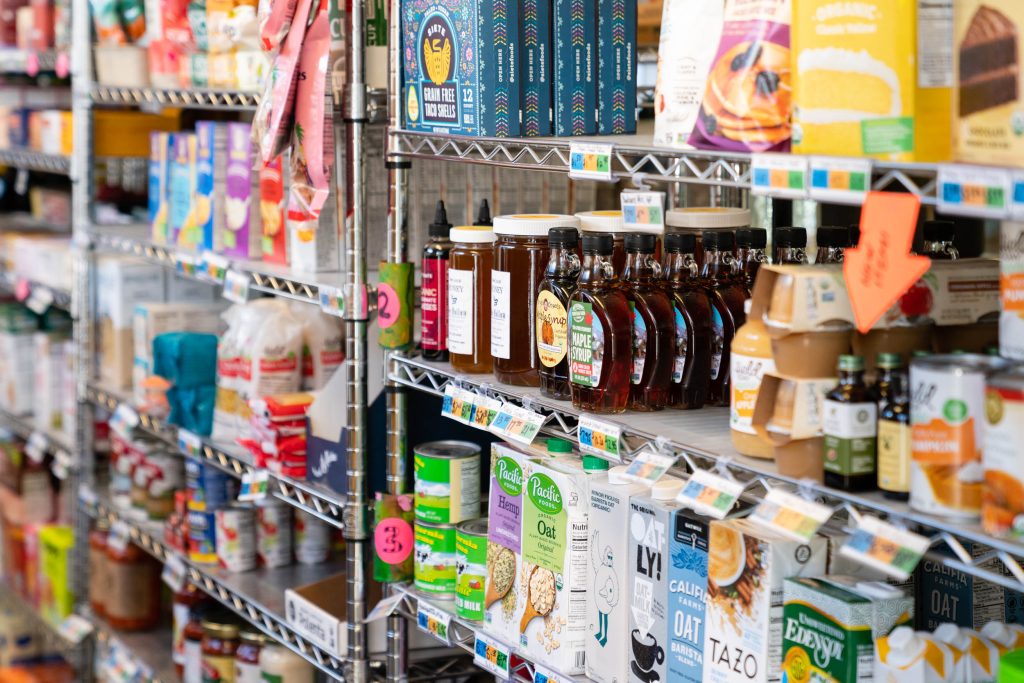
Rolling Grocer is a full-service grocery store in Hudson, New York with a mission to provide convenient, quality food for all — no matter the income level — with a priority placed on low-income residents. It accomplishes this goal with a variety of tools that we explore in conversation with Selha Graham, Rolling Grocer’s Head Buyer. Tools and partners appear in bold and some terms are also highlighted and linked to our glossary.
TS: How did Rolling Grocer come to be and what problems is it trying to address?
SG: Before it was Rolling Grocer, it was called Columbia County Mobile Market (CCMM) in 2017. That was the tagline we used from [community] listening sessions that we were doing. A group of people from the community of Hudson got together and talk about food access justice, what it would look like, what it would feel like, what could make it reasonable and economical and also equitable. So the name Rolling Grocer is about the rolling, the movement of food, the movement of access around the county and the 19 towns in Columbia County.
TS: What other needs were you addressing besides food access?
SG: There is the farm piece to suppor local agriculture, the entire food system. Have you ever seen in the produce section of ShopRite a list of farms where the produce is coming from? That’s what we mean by the farm piece. We directly want to support food, workers, and farm owners coming out of Columbia County. The closer you are to your food, the healthier it is. You also have emissions in play, and equity of the earth.
TS: As you were addressing this problem of food access, connecting local farms to the point of sale, what tools did you identify to help carry out that mission? We posted an article on our site about the Fair Pricing System. Can you talk about that?
SG: Fair pricing is a way for customers to pay what is fair, given a number of personal factors, including household income. We have three tiers of pricing and let people self-select what tier meets their needs. We trust customers to make an honest decision. We give some guidelines and assist with this, but ultimately it is up to you and you can change it at any time. All products are listed in the store with three prices and you pay a different amount depending on what tier you choose. It is similar to the concept of “fair wage.”
We have three tiers of pricing and let people self-select what tier meets their needs.

TS: What other tools have you used to support the local food system and to create food access?
SG: We utilize a mobile trailer as a tool to get food access to people in different neighborhoods. We realize there is a fissure in Hudson. If we put the store on Warren Street [the main shopping and tourist street in Hudson] we would be cutting out a large section of local folk. If we decided to be on State Street [a mixed-income residential street], we’d be cutting out a large section of tourists and people that are new to the area.
We utilize a mobile trailer as a tool to get food access to people in different neighborhoods.

TS: Tell us more about how the trailer works.
SG: Prior to and during COVID it was essentially the entire market. The trailer was the grocery store. It went to 5-7 stops during the week, and set up shop for 4-5 hours. It sold everything; bulk produce, meat, and most of that locally produced. In December of 2018 we experienced a very cold winter, and the trailer hadn’t been winterized for this area. We had to pivot to a storefront, but didn’t let go of the trailer. The trailer became housing and staging for curbside pickup during a pandemic. So it has had several iterations.
Next, it’s going to be set up as a farm stand. We’re going to put it on the outskirts of a small town or two, so residents can get groceries. It’ll be open a certain number of days a week. If you have data poverty [lack of access to wireless Internet), which is a real thing, then curbside won’t work because it’s online. That’s a sensitivity too. Even age affects how you interact with an online system. Having people there for walk-up [retail], drive up, or carpool into a spot that’s less than two miles away is huge [for underserved communities]. It changes their quality of life.
TS: When will the farm stand trailer launch?
SG: This spring and into summer. We are building right now to get to that point. We are partnering on this with Columbia County Recovery Kitchen (CCRK). We will be in the Berkshires, New Lebanon, East Chatham, and the Tivoli area. Ancramdale, Ancram, as well as Gallatin. Places where you won’t see a Trader Joe’s or a ShopRite.
You can find out locations on the website but we are also going to use volunteers to go door-to-door spreading the word. Create a mailer. We’re going to use the old school stuff because that never failed us.
TS: What is another tool you use?
Partnerships. CCRK is one. Hawthorne Valley Farm Store, Chester Aggregation Center, Department of Social Services. So those partnerships are tools to create synergies that push forward information and knowledge of the fair pricing system, the food access piece, the locality of [what we offer]. Right now, we are delivering to 17 towns with the CCRK partnership.
Another tool we use is watering holes. Places where people gather! We are in one right now! [Note: the interview took place in the Hudson Area Library]. We meet people where they are and get the word out in these watering holes.
Double Up Food Bucks works in tandem with EBT. Every time you buy meat, milk, bread, cheese, you can get tomatoes, oranges, lettuce, whatever, avocados, for free

TS: One last tool?
SG: Double Up Food Bucks works in tandem with EBT. Every time you buy meat, milk, bread, cheese, you can get tomatoes, oranges, lettuce, whatever, avocados, for free– up to $20 for spending $20 on groceries. It doubles your bucks specifically for produce. Because it’s not necessarily that people are hungry. They’re not hungry, they are malnourished. That’s part of the conversation that people tend to not want to talk about because it’s sensitive. It touches on culture, education, and on the ability to be able to have the utensils to cook. We found that a lot of people were saying they weren’t hungry, because they had food pantries and they had corner stores, but the corner stores never really had fresh fruit. So the Double Up Food Bucks grant came in and said to corner stores: “Hey we give you this money and say to you, every time someone buys groceries, you’ll carry some bananas, oranges, and they can get that for free.”
TS: Lastly, I want to ask if there are any additional tools you could use to support your work at Rolling Grocer?
SG: Ambassadors to spread the word, and volunteers to help with things like box breakdown, bulking, stocking, inventory, pricing, and labeling the meat.
Want to learn more about or get involved with Rolling Grocer 19? Visit them on their website, on Instagram @rolling_grocer_19, or on Facebook.